Each microservice operates within its container, completing orders, inventory control, and payment processing. A broken reputation, disappointed clients, and lost sales could result from one of these containers slowing down or crashing.
Here’s where container monitoring tools come into play. They closely monitor your containerized apps’ health and performance, warning you of problems before they become serious. Additionally, they let developers create apps in one setting, launch them in another, and use them anywhere.
With Docker and Kubernetes rapidly on the rise, it’s crucial to get container monitoring and log management right from the start. Knowing these monitoring tools is crucial as containerization gains speed in contemporary cloud environments.
The following article will discuss their importance, their functioning, the Top 15 container monitoring tools you can use for your computing needs, and the important metrics they monitor to help you efficiently manage your containerized apps.
Let’s Understand What Is Container Monitoring?
Container monitoring is the process of regularly gathering metrics and monitoring the state of microservices environments and containerized apps to make sure they are performing well and are healthy.
The metrics gathered are regularly tracked in real time and then analyzed to assess whether an application is completing its objectives.
Get exclusive access to all things tech-savvy, and be the first to receive
the latest updates directly in your inbox.
An application performance management (APM) solution that provides IT teams with a quick perspective to quickly create and deploy apps using DevOps principles is a container monitoring service.
The Role of Docker in Container Monitoring
We must explore the role of Docker in Container Monitoring, it makes the process of building, deploying, and maintaining containers easier, and Docker has become the industry standard for containerization.
It is easy to run applications in any environment by using Docker to package dependencies and applications into a single container.
Because of Docker’s growing popularity, specific container monitoring solutions have been created to keep an eye on Docker containers. These tools monitor parameters unique to Docker, like resource utilization, performance trends, and container health.
This makes it possible for organizations to maintain optimal application performance and get a deeper insight into their Docker environments by using these monitoring tools.
Why Use Container Monitoring Tools?
Organizations can make better decisions by having a better understanding of what’s happening not only at the host or cluster level but also within the container runtime and application.
Operators of containerized platforms benefit immensely from having visibility into logs, traces, and analytics. Examples of these decisions include when to scale up or down instances, tasks, and pods, adjust the type of instance, and make on-demand, reserved, and spot purchases.
Key Benefits of Container Monitoring Tools
- Assurance Performance and Stability: To avoid delays or crashes, keep an eye on the functionality and health of containerized apps in real-time.
- Optimize Resource Implementation: By balancing CPU, memory, and storage utilization, tools assist make sure containers operate effectively without using excessive or insufficient amounts of resources.
- Reduce Downtime: Receive notifications when problems arise with containers so that prompt solutions can be made before they cause problems. An e-commerce platform, for example, can stop service interruptions during periods of high demand.
- Scale Effectively: Keep an eye on resource consumption and automatically adjust container sizes to satisfy user requests, guaranteeing a seamless user experience even at busy times.
- Active Problem Detection: This helps businesses maintain a high degree of service reliability by identifying and correcting possible problems, like resource bottlenecks before they affect users.
- Monitor Key Metrics: To keep things running smoothly, tools like Prometheus or Grafana offer insights into CPU, memory, and network traffic usage, among other things.
Who Uses Them
You must be wondering where are these container monitoring tools being used, well there’s not one aspect that’s relying on it, I’m mentioning a few prominent areas or organizations that are making use of container monitoring and docker container monitoring.
Take a look at these:
- Tech Giants (Netflix, Google): Oversee thousands of microservices to ensure smooth operation.
- E-commerce sites (eBay, Shopify): Make sure they stay online during busy times.
- Financial institutions: keep an eye on safe, effective apps (JP Morgan, PayPal, etc.).
- Cloud providers (AWS, Azure, Google Cloud): They help manage container clusters that can be scaled and managed.
- DevOps Teams: Used by organizations of all sizes, to automate scaling and identify performance problems early.
- Healthcare (MedTech Businesses): Make sure vital health applications are secure and operational.
Top 15 Container Monitoring Tools Organizations Are Using in 2024
Here are the 15 best container monitoring tools with their unique features to consider:

- Sematext.
- Prometheus & Grafana.
- Dynatrace.
- Middleware.
- Datadog.
- SolarWinds.
- Sumo Logic.
- Splunk.
- cAdvisor.
- Sysdig.
- New Relic.
- Jaeger.
- CloudWatch (AWS).
- Scout.
- MetricFire.
1. Sematext

Having Docker container monitoring features, Sematext Monitoring is a lightweight full-stack observability solution for not only Docker but also for Docker Swam, Rancher, and Kubernetes with complete observability.
It offers an easier-to-set-up, more complete monitoring dashboard for logs, events, and metrics that gives you useful information about infrastructure and containers. Moreover, it provides orchestration support, log enrichment, anomaly detection, alerting, auto-discovery for new containers, and sensitive data masking. It can be used in the cloud or on-premises as well.
2. Prometheus & Grafana
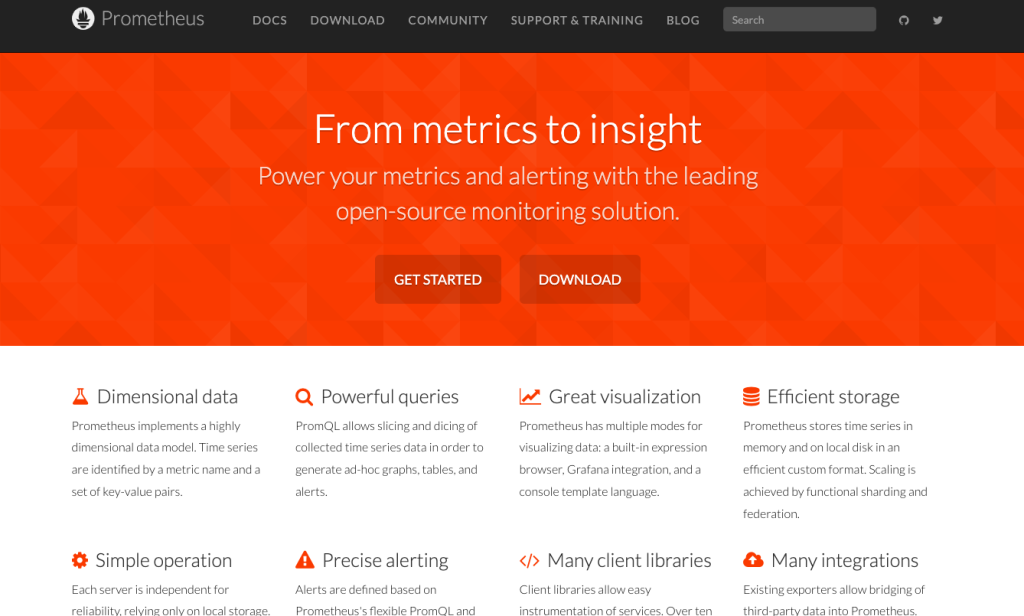
Prometheus & Grafana open-source container monitoring tools, Prometheus is designed to be dependable—it’s meant to be the system you turn to in an emergency so you can identify issues fast. Every Prometheus server is independent and does not rely on other distant services or network storage.
Docker, Kubernetes, and OpenShift are just a few of the systems on which Prometheus gathers metrics from containers in use. Grafana offers a platform for data visualization, analysis, and presentation in stunning visuals.
Data from ElasticSearch, MySQL, Redis, Prometheus, PostgreSQL, and other sources is entered into the Grafana suite of analytics analysis and visualization tools. Countless government and community-built dashboards are available for use.
It supports role-based access control (RBAC) for security and has its warning system. It is frequently used to view container metrics in conjunction with Prometheus.
3. Dynatrace
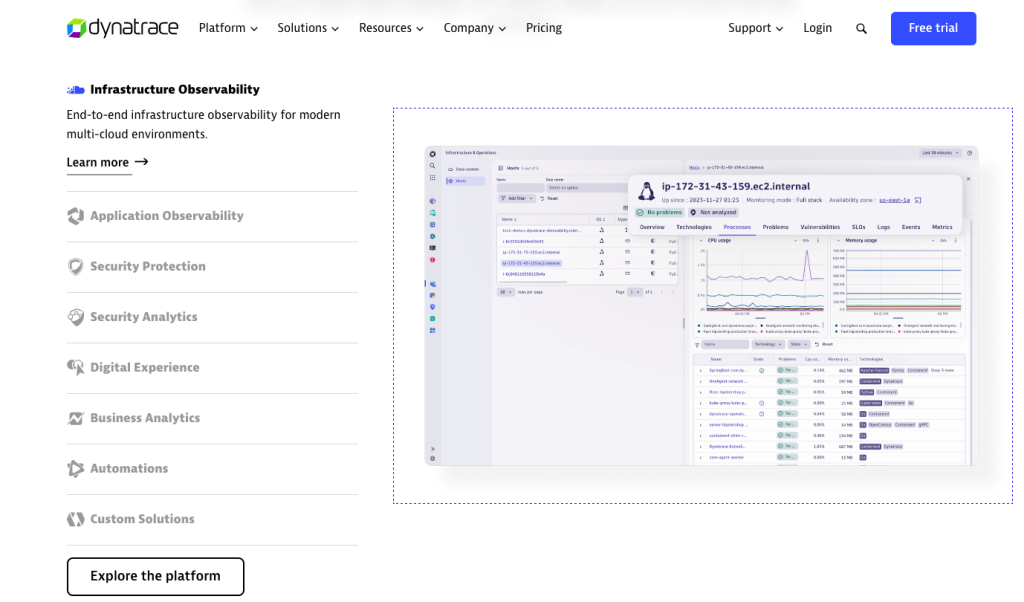
One of the many prominent container monitoring tools that let organizations monitor, optimize, and control the performance of their applications, infrastructure, and digital experiences using Dynatrace, a software intelligence platform.
Dynatrace is a full-stack observability solution that offers up-to-date information on how complex environments—such as hybrid infrastructures, cloud-native apps, and microservices—are performing. They actively detect and fix problems before they have an impact on users, which helps to improve the user experience.
Furthermore, Dynatrace reduces downtime by allowing for immediate issue resolution through real-time warnings and notifications. By automating a large number of monitoring and analysis processes, the solution also improves productivity and frees up teams’ time to focus on strategic projects rather than routine maintenance.
All things considered, using Dynatrace can greatly improve the dependability and performance of your applications.
4. Middleware
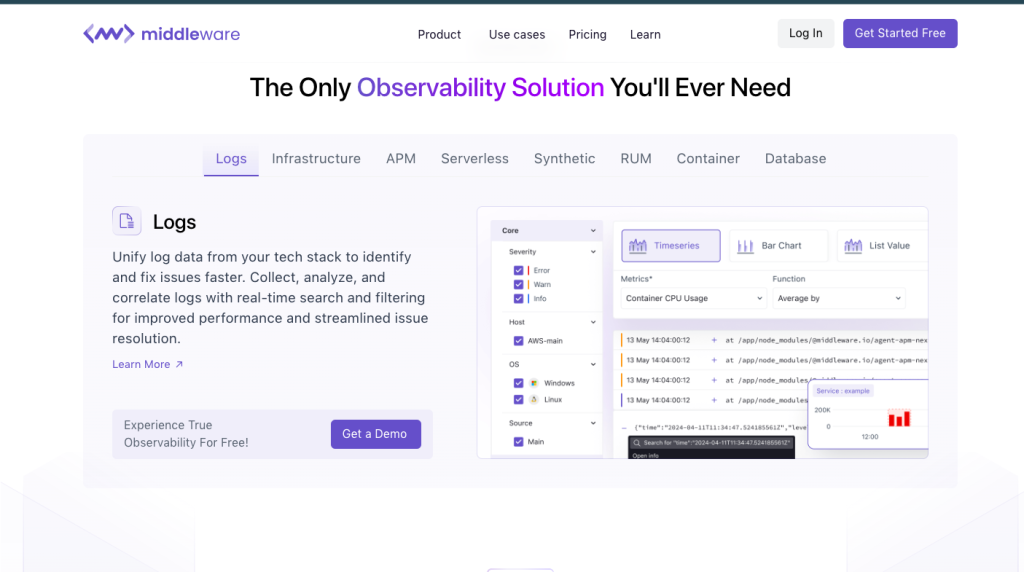
Specializing in intricate, multi-tiered applications, middleware is a container monitoring platform. It gives you complete, up-to-date visibility into the functionality and state of your containerized environments.
Middleware detects and monitors new or removed containers automatically to guarantee complete coverage.
Then, it enables users to keep an eye on Kubernetes and other containers, middleware providing a default dashboard that includes all important metrics configurations.
Also, captures real-time Kubernetes metrics, including replica counts and pod restarts, to offer insights into the performance and health of containerized applications.
5. Datadog

As an advanced container monitoring tools, Datadog integrates seamlessly with platforms like Kubernetes and Docker, making it ideal for managing complex and dynamic systems.
It offers complete visibility into containerized environments, making it simple to track health, resource usage, and performance. Any performance issue can be identified & fixed readily using Datadogs advanced analytics and visualization tools.
Just install the DataDog agent to begin gathering metrics, logs, traces, and event data from various sources—much like Dynatrace.
To provide full container observability, it also provides resource usage, tag-based anomaly detection, distributed tracing (including APM), and connectors with more than 20 different data sources and monitoring tools.
6. SolarWinds
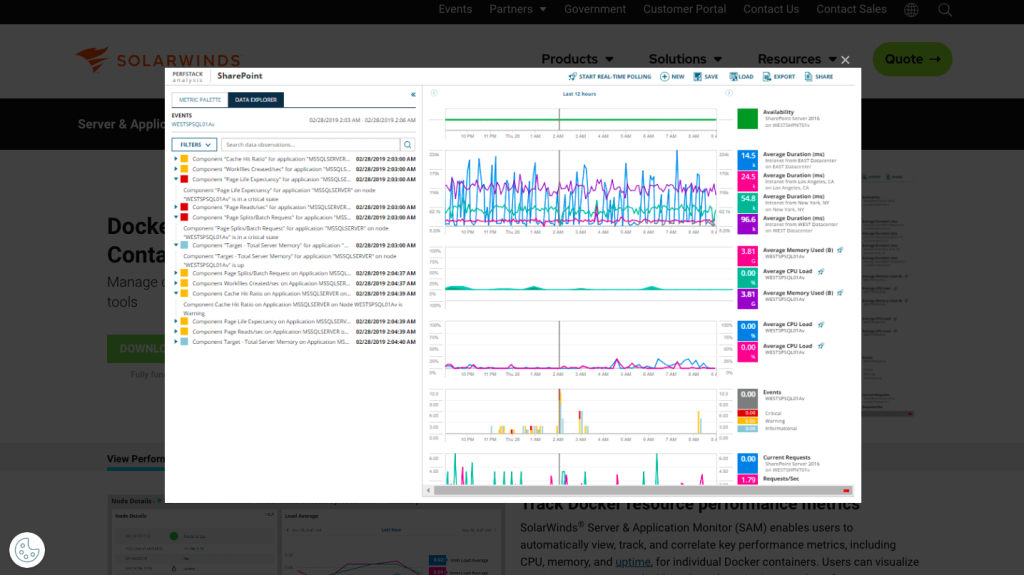
SolarWinds is also considered to be one of the best container monitoring tools being used today.
Allows users to see, track, and correlate important performance metrics for individual Docker containers automatically, such as CPU, memory, and uptime, as shown in the image above.
The three SaaS-based services, Docker, Kubernetes, and Docker Swarm 17.12 offer quicker troubleshooting and more in-depth insights. Additionally, SolarWinds gathers logs and data in Windows, Linux, Ansible, and Snap Chef environments. You may use Pingdom to track actual user experiences, Loggy for log management, and SolarWinds AppOptics (SaaS-based APM) for Kubernetes.
You can get instant alerts as notifications with SolarWinds, When resources are running, allowing for proactive monitoring and prompt action to guarantee peak performance.
7. Sumo Logic

Considered one of the most highly effective and comprehensive container monitoring tools that is designed for modern cloud environments.
Sumo Logic provides an extensive overview of targeted Docker systems by applying its container monitoring skills to host and daemon logs.
Sumo Logic is unique in that it can gather and examine metrics, traces, and logs from containers to provide you with a consolidated view of your infrastructure.
8. Splunk

Splunk is a successful real-time data collection, indexing, and analysis tool for machine-generated data. Large volumes of data may be tracked, visualized, and searched by enterprises, and it offers useful insights into operational health, security, and system performance.
The program provides, for instance, a Docker-collectd-plugin to gather data from Docker containers and a Kubernetes Analyzer to monitor Kubernetes environments (hierarchy view of nodes, pods, and containers). Application of metrics and traces, offering a more in-depth understanding of application performance.
Additionally, it is compatible with OpenTelemetry instrumentation, which makes it easier to integrate with current observability standards.
9. cAdvisor

cAdvisor, short for container advisor, is a clever open-source metrics collector developed by Google to examine and make available performance and resource utilization information from containers that are currently in use. Prometheus metrics are also exposed directly out of the box.
Gathers, combines, organizes, and exports container-related data. For each container, it maintains network data, resource isolation parameters, historical resource utilization, and histograms of all past resource usage. This information is exported both machine-wide and by container, especially in environments such as Docker.
With its lightweight design and ability to monitor resource use and provide simple data visualization, cAdvisor is a highly beneficial management tool for tracking container performance in Kubernetes systems.
10. Sysdig

Sysdig can be declared one of the best container monitoring tools, or you can say Docker container monitoring tool. Sysdig is the approved solution for monitoring containerized workloads by Docker itself.
With the help of Sysdig, users can identify and rank vulnerabilities in containerized settings, guaranteeing preventative security steps. Sysdig facilitates adherence to rules like PCI, NIST, SOC2, and more by automating compliance assessments for Kubernetes, containers, and cloud environments.
Also, the only cloud monitoring platform available for purchase works effortlessly with Prometheus. Developers now have a dependable tool without the administrative hassle.
Sysdig is said to be able to grow to millions of metrics with a single backend and long-term retention!
11. New Relic
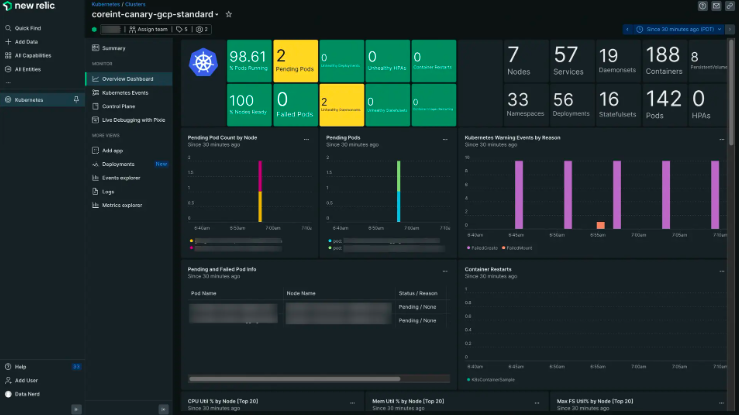
One of the most comprehensive container monitoring tools New Relic offers visibility in contexts utilizing containers.
Among the strengths of New Relic are its serverless monitoring capabilities, browser, API management, mobile, and extensive infrastructure. Metrics, distributed traces, logs, and event data are also available for monitoring containers in settings running Docker and Kubernetes.
You can debug your code in real time without sampling by using the Pixie tool. For example, you will need to install New Relic’s Kubernetes integration to view how your nodes, pods, containers, and the application interact.
12. Jaeger

Jaeger excels when compared to many container monitoring tools as it is highly focused on distributed tracing, a tool available as open-source software that is used to track and diagnose transactions in distributed systems.
Teams at Uber developed it, and in 2015, it became available to the public. Jaeger is a graduation project from the Cloud Native Computing Foundation.
Multiple requests from different services can be made during a single call. Large-scale transactions and distributed architectures, such as cloud-native microservices, are two areas in which Jaeger excels.
Traditional container monitoring tools tracked metrics such as CPU, memory, and network usage but Jaeger will give deep insights into how requests flow with complete visibility of every request lifecycle from other microservice-containerized environments.
13. CloudWatch (AWS)

An observability and monitoring service provided by AWS is called Amazon CloudWatch. You can set alerts, monitor and collect log files, track metrics, and react to changes in your CloudWatch in AWS resources.
For effective management and monitoring of your AWS resources, AWS CloudWatch is a necessary service. Your infrastructure and apps can operate more reliably, perform better, and spend less money if you deploy CloudWatch correctly.
CloudWatch works by collecting logs and metrics from your AWS resources, evaluating the information, and delivering alerts and visualizations.
It is made up of three primary parts:
- the metrics and monitoring section that gathers data from resources,
- the CloudWatch long-term storage of that data,
- the visualization and alert sections that are dependent on the data that has been stored.
You get free storage of the metric data with a 1-minute granularity for a maximum of 15 months.
14. Scout

Compared to other container monitoring tools Scout is a powerful one, focused on APM (application performance Monitoring), especially designed with developers using containerized environments in mind.
Scout is superior to cAdvisor in that it enables hosted monitoring. The tool offers real-time error tracking and performance monitoring, enabling developers to identify significant issues and performance bottlenecks before users report them.
Similar to Jaeger’s distributed tracing, Scout provides smooth trace data that enable root cause analysis and troubleshooting by identifying delayed transactions and evaluating past performance trends.
For example, Scout retains data for extended periods, gathers data from several hosts and containers, and initiates alerts predicated on particular parameters.
15. MetricFire

MetricFire uses a collection of open-source container monitoring tools to deliver a comprehensive platform for application and infrastructure monitoring. Send metrics to Hosted Graphite with ease, and see your metrics in real-time on stunning dashboards.
Using Grafana’s stunning dashboards, you can use it to view the status of Kubernetes and Docker containers instantly. Additionally, it is integrated with Prometheus, Rancher, and cAdvisor.
And, predicated on the Prometheus/Grafana/Graphite open-source technologies. MetricFire offers the hosted version of that combination, which means having access to all of the open-source projects’ dashboards and plugins in one location.
Final Thoughts
For containerized environments to be efficient, secure, scalable, and perform well, leveraging powerful container monitoring tools is essential in for your cloud environments.
These solutions give businesses the ability to see inside their containerized apps, take proactive measures to fix problems and maximize resource use.
Organizations may fully utilize containerization to drive innovation and efficiency in their operations by selecting the appropriate technologies and realizing the importance of container monitoring.
FAQ’S
What are container monitoring tools?
Software programs called container monitoring tools are made to keep tabs on the functionality, state, and resource consumption of applications that are containerized.
For container monitoring, why is Docker important?
Docker makes it easier to create and manage containers, and to ensure optimal performance, monitoring tools are specifically designed to track metrics particular to Docker.
Container monitoring tools are useful for whom?
These technologies might be useful for DevOps teams, system administrators, cloud service providers, developers, and organizations that use microservices.
Which key metrics are tracked by container monitoring tools?
They monitor things like response times, network traffic, CPU and memory utilization, and container health.
Which container monitoring tools are in demand?
Prometheus, Grafana, Datadog, Sysdig, New Relic, and Kubernetes Dashboard are a few well-known tools.



